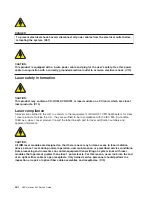
Powering the system on and off
For procedures to power off and power on the system for various system configurations and operating
systems, see “Stopping the system” on page 310 and “Starting the system” on page 311.
Console strategy
The NAS Gateway 500 is a headless system (that is, without a display interface permanently attached or
part of the normal NAS Gateway 500 configuration). Serial port 1 is reserved for the system console. A
console attached to serial port 1 allows access to the service processor, POST messages and other
service aids, such as running diagnostics from the CD-ROM drive.
You can also use a personal computer (PC) as a console using a null-modem cable. The PC would
require a terminal emulation program (for example, HyperTerminal on Windows and vt100 emulation
mode) to act as the console interface. Specific communication settings depend on the system; however,
these are typical settings:
v
9600 baud
v
8 data bits
v
1 stop bit
v
No parity
v
Xon/Xoff or hardware
The firmware starts a console-selection sequence at system boot time if any of the following is true:
v
A console has not yet been selected.
v
A previous console-selection sequence timed out.
v
A change in the system configuration affects the console.
The console-selection sequence allows you to select (from the appropriate input device) any one of the
available console devices. If no console is selected within approximately 60 seconds, serial port 1 (S1) is
selected as the console and the selection sequence times out.
Attention:
If an ASCII terminal is attached to serial port 1 (S1), and there is any interaction with this
terminal:
v
After
OK
is displayed in the operator panel
AND
v
Before the power-on sequence is initiated
the firmware will use this terminal as the console, regardless of the previous console selection.
After a console has been selected, the console-selection sequence is started at boot time only if there is a
change in the system configuration (as previously described), or the contents of the system’s nonvolatile
memory (NVRAM) are lost.
You can also initiate a system console-selection sequence from the SMS menus.
Power-on self-test
After power is turned on and before the operating system is booted, the system does a power-on self-test
(POST). This test performs checks to ensure that the hardware is functioning correctly before the
operating system is installed. During the POST, a POST screen is displayed, and POST indicators appear
on the firmware console (if one is connected). The next section describes the POST indicators and
functions that can be accessed during the POST.
6
NAS Gateway 500 Service Guide
Summary of Contents for TotalStorage NAS Gateway 500
Page 1: ...IBM TotalStorage NAS Gateway 500 Service Guide GY27 0418 00 ...
Page 2: ......
Page 3: ...IBM TotalStorage NAS Gateway 500 Service Guide GY27 0418 00 ...
Page 16: ...xiv NAS Gateway 500 Service Guide ...
Page 20: ...xviii NAS Gateway 500 Service Guide ...
Page 36: ...System logic flow Note Not all components are supported 16 NAS Gateway 500 Service Guide ...
Page 52: ...32 NAS Gateway 500 Service Guide ...
Page 58: ...38 NAS Gateway 500 Service Guide ...
Page 112: ...92 NAS Gateway 500 Service Guide ...
Page 266: ...246 NAS Gateway 500 Service Guide ...
Page 326: ...306 NAS Gateway 500 Service Guide ...
Page 353: ...Chapter 11 Removal and replacement procedures 333 ...
Page 392: ...372 NAS Gateway 500 Service Guide ...
Page 402: ...382 NAS Gateway 500 Service Guide ...
Page 412: ...392 NAS Gateway 500 Service Guide ...
Page 440: ...420 NAS Gateway 500 Service Guide ...
Page 446: ...426 NAS Gateway 500 Service Guide ...
Page 448: ...428 NAS Gateway 500 Service Guide ...
Page 466: ...446 NAS Gateway 500 Service Guide ...
Page 469: ......
Page 470: ... Printed in U S A GY27 0418 00 ...
Page 471: ...Spine information IBM TotalStorage NAS Gateway 500 NAS Gateway 500 Service Guide GY27 0418 00 ...
















































